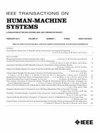Haptic Shared Control for Dissipating Phantom Traffic Jams
IF 3.5
3区 计算机科学
Q2 COMPUTER SCIENCE, ARTIFICIAL INTELLIGENCE
引用次数: 0
Abstract
Traffic jams occurring on highways cause increased travel time as well as increased fuel consumption and collisions. So-called用于消除交通拥堵幻影的触觉共享控制装置
高速公路上发生的交通堵塞会导致行车时间增加、油耗增加和碰撞事故增加。所谓的 "幽灵交通堵塞 "是指没有明确原因的交通堵塞,例如并线匝道或事故。幽灵交通拥堵占所有交通拥堵的 50%,是由人类驾驶行为导致的交通流不稳定造成的。只需将车流中 5%的车辆纵向运动自动化,就能消除幽灵交通拥堵。然而,当人类驾驶员需要接管自动化控制时,驾驶自动化会带来安全问题。我们研究了是否可以使用触觉共享控制来消除幽灵交通堵塞。这将使人类保持在环路中,从而绕过了人类接管控制能力有限的问题,同时受益于自动化的大部分优势。在一项有 24 名参与者参加的驾驶模拟器实验中,我们测试了触觉共享控制对交通流动态的影响,并将其与手动控制和全自动控制进行了比较。我们还研究了两种控制类型对模拟无声自动化故障时参与者行为的影响。结果表明,与完全手动控制相比,触觉共享控制能更好地帮助缓解幻象交通堵塞,但与完全自动化相比,触觉共享控制的效果要差一些。我们还发现,与全自动驾驶相比,触觉共享控制能减少无声自动驾驶故障导致的不安全情况的发生。我们的研究结果表明,触觉共享控制可以消除幽灵交通堵塞,同时防止与全自动驾驶相关的安全风险。
本文章由计算机程序翻译,如有差异,请以英文原文为准。
求助全文
约1分钟内获得全文
求助全文
来源期刊

IEEE Transactions on Human-Machine Systems
COMPUTER SCIENCE, ARTIFICIAL INTELLIGENCE-COMPUTER SCIENCE, CYBERNETICS
CiteScore
7.10
自引率
11.10%
发文量
136
期刊介绍:
The scope of the IEEE Transactions on Human-Machine Systems includes the fields of human machine systems. It covers human systems and human organizational interactions including cognitive ergonomics, system test and evaluation, and human information processing concerns in systems and organizations.
 求助内容:
求助内容: 应助结果提醒方式:
应助结果提醒方式:


